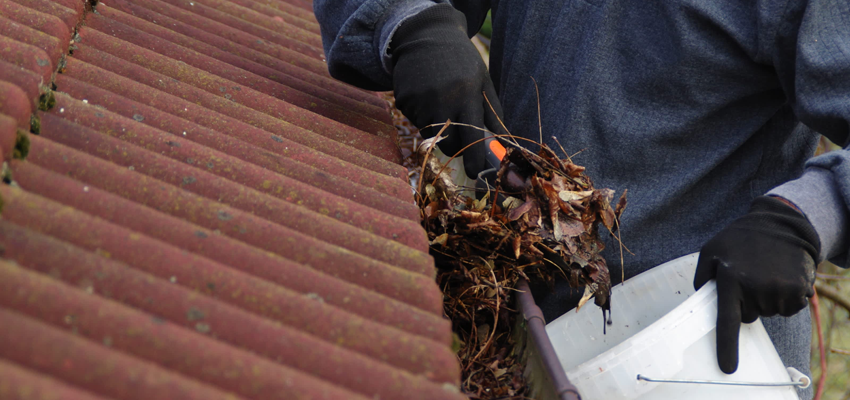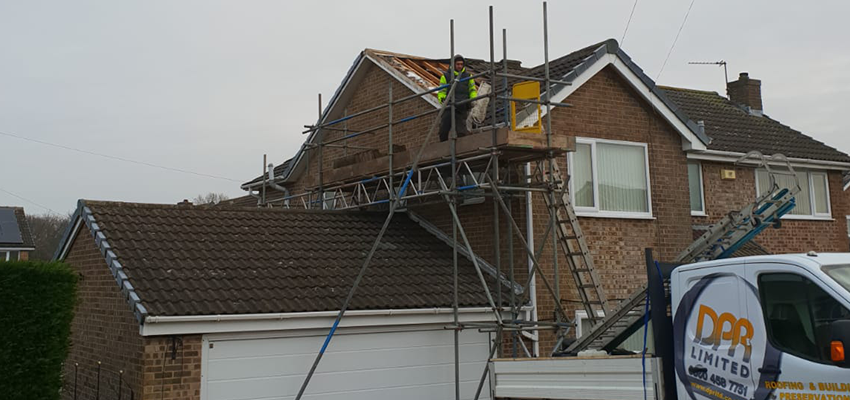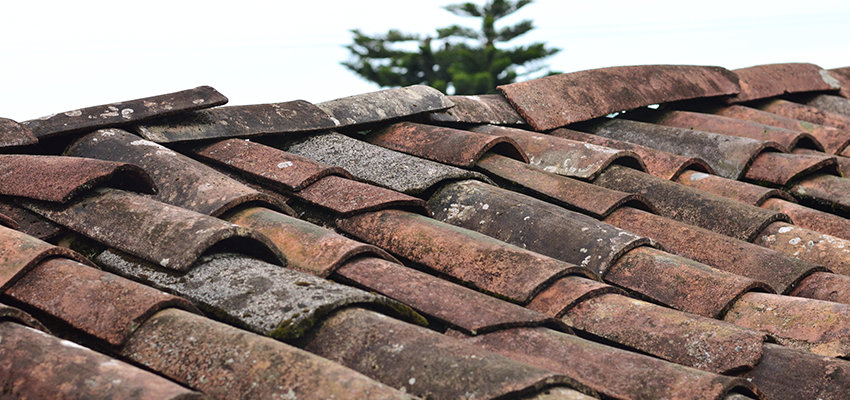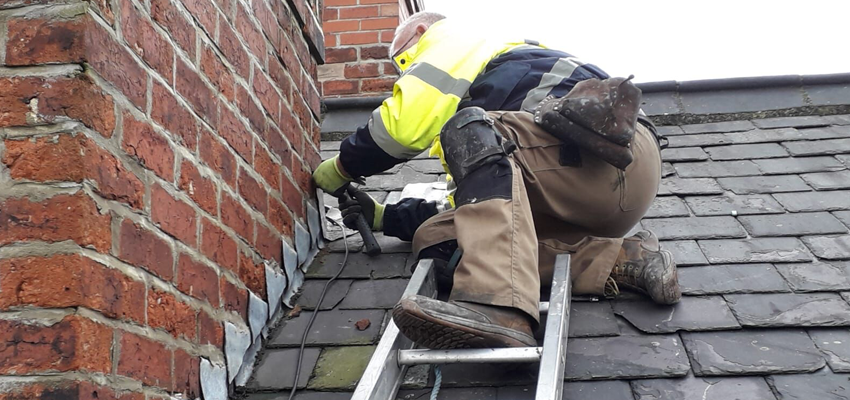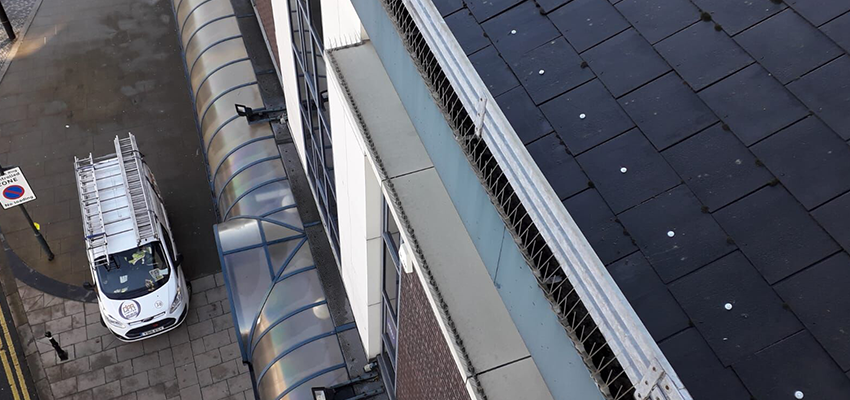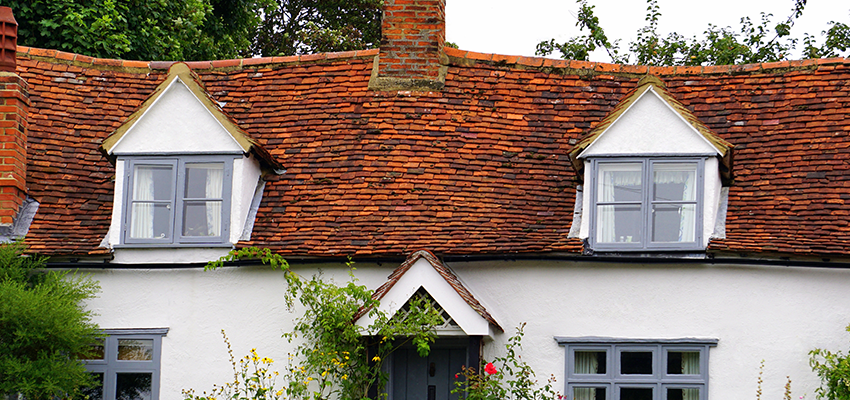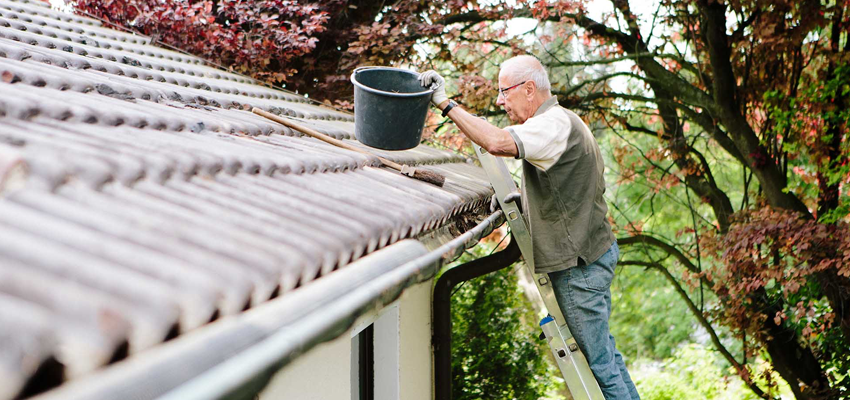3 Reasons Why DIY Roofing is a Terrible Idea
When it comes to roof repairs, we understand that the costs can add up quickly. As a result, a number of property owners are tempted to opt for the DIY route when it comes to simple roofing repairs. Unfortunately, this can end up costing much more in the long run and could even result in damage to both your home and yourself.
Whether you’re considering a small DIY roofing repair or thinking of replacing your entire roof, there are a few factors to think about before climbing the ladder and tackling your own roof. Keep reading to discover 3 reasons why DIY roofing is a terrible idea.
1. Potential dangers
Without the proper training, roofing can be a dangerous, potentially even fatal task. Chances are, you don’t have the equipment or manpower necessary to protect yourself, your home and your loved ones from any roofing mistakes.
Even if your property is a bungalow and you’re not worried about falling off, a drop as small as 10-15 feet can cause serious injury. Professional roofers are not only trained to work at a great height, but they have the experience of working in different weather conditions and with different materials, so there is less risk of anything going wrong.
2. Expensive mistakes
If you make a mistake when attempting to fix your own roof, even if you think it is unimportant, it could end up being rather costly later on. You may think you’re saving money by taking care of the roof yourself, but unless you have the right materials and proper tools, you may do more damage than good.
A roof repair or replacement isn’t as simple as fixing a pipe or changing a light switch. You may not even know where the issue is coming from. Trying to locate the problem, repair it and ensure your roof is still in good working order can be challenging when you don’t have the necessary training.
3. Time-consuming
Even for professional roofers, replacements or lengthy repairs can take up to a few weeks, depending on the issue. So, just imagine how long it would take you. If you’re tackling a roof repair yourself, you must be prepared to put in the hours of work needed to finish the job.
The last thing you want is to get halfway in before realising you simply don’t have the time and then you’re left with a partly fixed roof that could create further issues for your home and its structure. Professional roofers understand how to protect your roof during the night and prevent weather damage while the work is in progress.
Choosing a professional
Put simply, roofing is not a DIY task. It is complicated, dangerous and time-consuming – and only professionals should attempt it. At DPR Roofing Barnsley, we offer cost-effective roofing services for residential and commercial properties in the local area. Whether you need an entirely new roof or a few simple repairs, our friendly team is here to help.
How Long Does It Take to Clean Your Gutters?
Guiding water away from your home, preventing moisture damage and stopping a build-up of water backing up in to your roof – your property’s guttering is highly important. Keeping your gutters clean and free of debris is essential for maintaining a protected, leak free home.
That’s why it’s vital to have your gutters regularly checked and cleaned. But what exactly is involved in a gutter clean? And how long does it take? Keep reading to learn more.
Protecting your property
The amount of time needed to carry out a gutter clearance depends on a number of factors, including:
Size
It goes without saying that bigger properties will have more guttering around the perimeter. A typical semi-detached home in Barnsley will take up to 2-3 hours from start to finish, for example. However, the bigger a property gets, the longer it’s going to take.
Type of property
Older properties generally take a little more work as they don’t have the necessary implementations to prevent gutter blockages. When they were built, there was little concern for clogged gutters, so they take a little more work to fully ensure they are clear.
Weather conditions
Unfortunately, the weather impacts all aspects of outdoor work. Whether its pouring rain or howling winds, it is simply not safe to work in some weather conditions. Bad weather could delay your gutter clearance and may impact how long it takes due to broken pipes or built-up blockages.
DIY vs Professional
You may opt to give gutter clearance a go yourself, but you could spend hours up the ladder picking out leaves. A professional clean will be quicker and save you the effort. We don’t recommend attempting any guttering jobs without proper equipment and training.
Quality of job
You may find the quoted time varies slightly from business to business. This could be down to staff availability or experience but could also be a reflection on the quality of the job. If one quote appears much quicker than the rest, it may be a sign of a rushed job.
Professional roofing experts in Barnsley
Regular gutter clearance should definitely be a part of your annual to-do list, especially before and during the winter months. As well as protecting your home from the harsh elements, regular guttering cleans can help alert you to potential issues on both your gutters and your roof.
The team at DPR Roofing in Barnsley have the knowledge and experience to quickly and effectively clear your gutters, while checking for any issues or potential future problems. We carry out expert guttering and roofing work in the local area, helping to protect both domestic and commercial properties.
Take a look at our past work for a clearer idea of the guttering clearances and replacements we have carried out recently.
We will photograph your gutters inside to show you we have cleaned them thoroughly.
Extension Roofing: Flat Vs Pitched
When it comes to designing an extension for your home, there are a number of factors to consider. How large do you want the space to be? How should the interior be laid out? How many windows do you want? Sometimes, the exterior of your new room is the last thing on your mind.
But the design of the roof can make one of the biggest differences when it comes to appearance, function and practicality of a new extension. Choosing between having a flat or a pitched roof may initially seem simple, but with so many pros and cons of each design, it can be harder than you may think.
Keep reading as we discuss the difference between the two and help you decide which design is right for you and your home.
Flat roof
While it’s the less common roof design of the two, flat roofs offer a unique and sometimes modern look for many homes and extensions. With the option to add a skylights, flat roofs allow a lot of light into a room, creating a sense of openness and a large amount of space.
A flat roof can also create a clean and seamless transition from the existing property to the extension, reducing the chance of neighbours complaining. The roof can’t be installed to the same height as a pitched roof, decreasing the overbearing effect.
The main benefit of flat roofs is the cost. They’re considerable cheaper than pitched roofs, because they require less materials and less time to install. That said, they typically require more maintenance.
Pitched roof
A pitched roof offers both function and aesthetic benefits for a new extension. The design can be integrated easily into the original look of your home and can be installed to keep with the design of your property.
Pitched roofs can also let in a natural light with skylights adding an airy, spacious feel to your extension. However, the real benefit comes from the added height, with more roof space on a pitched roof.
While they may cost more, the increased longevity and savings on maintenance could be well worth it.
Which is best for me?
Both flat and pitched roofs offer their own benefits to a new extension. It’s important to consider the look of your property, as well as the structural design and your overall expectation for the space.
If you’re working with a smaller area, a pitched roof may work well to open up the area, offering more height. Or if you want to cut back on costs, a flat roof might be the best option.
Whether you opt for a flat roof or pitched roof, it’s important to have it installed properly so you don’t face recurring problems further down the line. DPR Roofing in Barnsley can help provide exactly that. We install strong, high-performing and long-lasting extension roofs for domestic properties across the region, with over 35 years’ experience in the industry.
How to Spot Cowboy Roofers: 4 Tell-Tale Signs
We’ve all heard tales of cowboy roofers, whether it’s leaving work unfinished or just charging over the odds for ‘unexpected costs’. That said, nobody expects to fall victim to a cowboy when they need repairs on their own property.
Unfortunately, cowboy roofers do still operate and continue to con innocent homeowners out of their hard-earned money for sub-par work. The good news? There are ways to spot them and steer clear before they get a chance to work on your property. Read on as we look at 4 tell-tale signs of cowboy roofers.
1. Plain vans
It sounds cosmetic, but a good roofing contractor will care about how their business looks. This extends to their vans, which will have a company name, branding and even contact information.
In contrast, cowboys are known for operating under several names, whether that’s a different business name or even giving out fake details. With that in mind, they will use a plain, unbranded van, so they can continually up sticks and con more people for poor repairs. If the van is branded be wary of mobile numbers only as they cannot be traced when the job goes wrong.
2. Personal appearance
It’s not just the appearance of their fleet which shows a contractor’s worth. You should also consider the appearance of the contractor and their workers. Quite often, they’ll turn up for jobs wearing denim jeans and trainers, not to mention the smell of cigarettes and alcohol, showing just how unprepared and unprofessional they really are.
On the other hand, trustworthy contractors know the appearance of having the right equipment and wearing the right clothes. They will wear proper work trousers and boots, which typically reflects in the end result – a roof you can rely on, rather than one that needs even more work.
3. A lack of knowledge
As with any contract work, it’s best to get a thorough inspection and quote before proceeding. When doing so, be sure to ask plenty of questions about materials, aftercare and what caused the problem. With a cowboy roofer, you’ll probably find that they lack anything other than the basic knowledge. A bit of digging will soon see them stuttering and trying to divert your attention. Get some terms off the internet and challenge them with scenarios and see how they react.
4. No online presence
As well as ‘digging’ in person, it’s worth doing your research online to separate the real contractors from the cowboys. Established contractors will have their own website, an up-to-date page on social media and will typically have some reviews.
If you can’t find any of these, you should definitely think twice about using a contractor. Why don’t they have a website in 2019? Why can’t you find any reviews for them? In most cases, it’s because they go by several names, so they can repeatedly flee the scene.
Don’t chance it
DPR Roofing in Barnsley is an established team of roofing specialists, with over 35 years’ experience in the industry. We don’t use cheap materials or try to patch things up. Instead, we identify the root cause of your roofing problem and provide a strong, long-lasting solution with a comprehensive range of commercial and domestic roofing services.
Questions You Should Definitely Ask Any Roofing Company
Before you dive right in with your roof repairs, there’s a few questions you should definitely ask any roofing company. When it comes to professionalism and top-quality results, you want the best team for the job. Fortunately, with some preparation and a few details, you can put your mind at ease and look forward to your brand-new roof. This post looks at 4 must-ask questions for your roofing company.
- How long have you been in business?
Experience is crucial when you’re searching for contractors. Ask roofing companies how long they have been in business, to check that they’ve got plenty of experience in the industry. Inexperience can easily lead to problems further down the line. Ask for proof of their time in business.
- Can you provide references?
As well as experience, it’s important to ask your roofing contractors about previous projects. The best way? Ask for references. This will give you a clear indication about what types of jobs they can handle and if they’re up to the task, with confirmation from past customers. Tell them you want to look at the jobs to see if they are of good quality. If they make excuses then so should you and don’t use them.
- What accreditations do you hold?
Be sure to check the roofing company is accredited. Organisations like the Federation of Master Builders and Confederation of Roofing Contractors show that contractors are reputable, skilled and trustworthy in their industry. Safe Contractor or CHAS is also a must, ask for proof of safe working.
- Do you have insurance?
When choosing a roofing company, ask if they have insurance. Ensure that the contractors are fully covered for both public and employer liability. This protects the homeowner and the roofing company employee if injury or damage occurs. Ask for a copy of their certificate.
- Is your work guaranteed?
Ask the roofing company if they offer a warranty for their work. Most companies offer at least a one year guarantee dependent on the type of work you want many credible companies will offer long term warranties also. It’s better to be safe than sorry and ask for these details at the beginning of the process. Remember, the price is what you pay and value is what you get. Need a new roof? If you’re a homeowner or manager of commercial premises and need roof repairs, DPR Roofing can help. Based in Wakefield, we have over 29 years’ experience in roofing. We offer a stress-free approach to all your roofing needs, whether it’s a repair, replacement or inspection. Get in touch today and let us know how we can help you.
A Brief Guide to Roofing Terminology for New Buyers
Searching for your first home? If you’re going to make the right choice, you need a house with a roof that’s going to stand the test of time. Property viewings are by no means a walk in the park, but they’re made much easier if you know the right terminology and what to look out for. Read on as we look at some important roofing terms for first time buyers:
Deck/structure This is the structural underlay of your flat roof, typically made from timber floorboards or plywood. On a property viewing, it’s worth taking a look into the loft to check everything is structurally sound and there are no clear signs of damage or decay to any visible areas. If there is no access then get a roofer to assess the condition, you may have to pay a survey fee but the information received may prove invaluable.
Guttering
Guttering refers to the property’s rainwater gutters, which run around the roof’s perimeter. They collect water and divert it away from the property. This protects the building’s exterior surfaces as well as its foundations, and prevents water getting inside your home. Check that gutters are in good condition, as broken guttering could indicate further problems elsewhere.
Moss
While we’re all aware what moss is, not everyone knows what it means for a roof. It’s a fungus which traps moisture on the roof, causing roofing materials to rot over time. Some people may think it looks pretty having a large moss collection on the roof but the damage is slowly occurring. Removal is essential.
Pitch
A roof’s pitch is the angle at which it slopes. Low pitched roofs are less than 25 degrees, which is worth looking out for, as it can make replacement and repairs more problematic in the future. May low pitch roofs are covered in the wrong materials due to unscrupulous past roofers, get it checked if there is an indication of a low pitched roof.
Roofing materials
There are a variety of roofing materials, and it’s a good idea to learn the basics about each of them so you know what they mean for your potential first home:
- Concrete tiles – A durable and versatile roofing material, which typically lasts for around 50 years.
- Clay tiles – Slightly lighter, longer lasting and lower-maintenance compared to their concrete alternative, but also more expensive as a result.
- Slate – Made from natural mined slate, these last upwards of 70 years and give superb kerb appeal to properties.
Ventilation
Roofing ventilation allows moisture out of the home in the form of humid air. Without it, moisture gets trapped in the roof space and damp or mould begin to develop. It’s worth asking about ventilation when viewing a home. Ventilation is relatively cheap to install so do not risk a loft without any at all.
Need anything else?
Our brief guide should stand you in good stead for your property search. But if you find you need any more assistance, be sure to get in touch with the team at DPR Roofing Barnsley. We’re a team of roofing specialists, providing new roofs, roof replacements and roof repairs to residential and commercial properties across Barnsley and the surrounding areas. We’re also experts in gutter repairs and gutter clearance. We are owners of high access hydraulic platforms which saves on expensive scaffolding and means emergency jobs can be done often within a few hours. There’s no job we can’t complete to the highest standard. Get in touch today to speak more about our services.
Commercial Vs Domestic Roofing: Understand the Differences
If you own or run a commercial property, you’ll likely have to deal with roofing at some point. No problem – you can just draw on experience from your home, right? Wrong. There are a number of differences between commercial and domestic roofing. And it’s important to understand what separates them when you’re looking for repairs or a replacement. Read on as we discuss the key differences between the two.
1. Size, design and access
While there are many exceptions, most commercial roofs have a low-slope or are completely flat. They’re also much bigger than typical domestic roofs. In contrast, domestic roofing tends to have a higher pitch and is relatively small. As well as being smaller, the vast majority of domestic roofs can be accessed using conventional scaffolding. However, for commercial roofs, it may be more suitable to use a mobile elevating work platform. Another design difference is the external pieces – such as piping and air flow systems – that commercial roofs have to accommodate. Domestic roofs don’t tend to have anything other than a chimney stack.
2. Cost and maintenance
Pitched roofs typically cost more than flat roofs of the same size. That said, a commercial roof will normally cover a much larger area than a domestic one, so it’s going to set you back more overall. Pitched roofs also require less maintenance and generally last a lot longer. As a result, you can usually expect a commercial roof to cost more in maintenance and repairs, which could be anything from patching up cracked roof sheeting to a complete recoating.
3. Materials
Because they have a larger surface area, commercial roofs use affordable, functional bituminous materials to provide a waterproof covering. For a more long-lasting solution, you can also opt for robust single-ply membranes, which are applied as a liquid and set to provide complete weather resistance. Another option is Plastisol roofing sheets (steel profile sheets coated in a coloured plastic) On the other hand, domestic roofing uses materials that are more focussed on appearance. Concrete tiles, clay tiles and even slate can be used on domestic properties, which boost a property’s appearance and value. When maintained properly, these materials can also last several decades.
4. Urgency
A final difference is the urgency when it comes to repairing a commercial or domestic roof. It’s important to get domestic roofing repairs as soon as possible, to stop problems developing into something worse. However, with commercial roofing, things can be even more serious. If you’re letting out your commercial space to other businesses, or even just housing your own business, any leaks or water ingress could pose a health and safety risk. It’s imperative to have your commercial roof repaired or replaced as soon as possible to avoid any tricky legal situations.
High quality roof repairs
Whether you need maintenance, repairs or a full replacement, DPR Roofing offers a wide range of high-quality roofing services for both domestic and commercial properties. With over 29 years’ experience, we’re best placed to provide the perfect, long-lasting solution for any roof.
Complete Guide to Flat Roof Insulation Regulations
When it comes to roofing, there are a wide range of regulations for property owners to follow. Things like pitch, roof structure and the materials used are all regulated. But so too is roofing insulation, which is critical to a roof’s performance. So, what exactly do you need to know? Read on as we discuss flat roof insulation regulations.
Why roof insulation matters
Every building has an envelope which separates it from the external environment. It’s made up of the foundation, walls – including doors and windows – and the roof. If any of these physical components is poorly insulated, it allows heat to easily escape the building and makes it much harder to keep the interior warm. That’s why roofs require effective insulation. However, it’s not just about making things easier for property owners. Government building regulations are also concerned with the conservation of fuel and power. If buildings don’t have the right level of roof insulation, they’re going to need more fuel to keep them warm which means more impact on the environment. To combat this issue, new roofs have long-had to meet building regulation standards for insulation (U values). Since 2006, this has also applied to refurbishment on existing flat roofs.
What the Building Regulation says
Part L of the Building Regulation outlines two separate regulations for flat roof insulation. It depends on whether the roof is on a new property or an existing building:
- New flat roofing insulation – The roof must have a U value of 0.13 W/m2K or lower.
- Existing flat roofing insulation – The roof must have a U value of 0.18 W/m2K or lower.
Cold deck vs warm deck
Roofs can have two types of insulation: warm deck or cold deck. Warm deck insulation is when insulation is placed at rafter level, so the deck stays warm, while cold deck leaves the deck cold with insulation at ceiling level. For pitched roofs on existing properties, there are slightly different U values depending on the type of insulation they use. However, the values are the same for flat roofs regardless of their insulation type. What this does affect is how insulation is installed. As a general rule, most flat roofs require a minimum of 100mm insulation in the voids to achieve the right level of insulation. If the roof is insulated with a cold deck, it typically requires a ventilated cavity of around 50mm to allow air to flow and prevent moisture build up.
Can we help?
Roofing regulations can be complex without the right training, that’s why it’s important to get roofing experts for any new flat roof or flat roof refurbishment. DPR Roofing Barnsley is a team of roofing specialists with over 29 years’ experience. Our fully-trained team is ready to tackle any job. To arrange a free quote today, or get more information about any of our services, contact our team today.
Why Spring is the Best Time for a Roof Health Check
We’re all familiar with spring cleaning. Homeowners love to get their interiors in order once the days start brightening up. But what about the exterior of your property? Spring is the ideal time to give your property the once over on the outside too. And that includes your roof.
Read on as we look at why spring is the best time to check the state of your roof and how to go about doing it.
Winter of discontent for your roof At last, we can wave goodbye to winter. Cold, wet days and long, dark nights are nobody’s idea of fun. And they’re hardly a joy for your roof. There are a number of problems that the winter weather can cause for your roof. First of all, snow. It may not be constant, but the UK typically gets one or two periods of heavy snowfall over winter. This means extra weight for your roof to bear. It can weaken parts of your roof or expose existing issues. Ice and freezing temperatures are another issue as they cause freeze-thaw action to occur. This is when water gets into small cracks or porous roofing materials and expands as it freezes. Over time, the recurrence of freeze-thaw can cause larger cracks to appear and allow water to penetrate your roof. More than a breeze On top of all this, the UK endures much higher wind speeds through winter. Strong winds can loosen some roofing materials if they have been poorly installed or already weakened through years of wear and tear. The result? Roof tiles may slip out of place or fall off your roof altogether. Loose guttering can also be affected by these strong winds. That’s not even mentioning potentially dangerous debris like tree branches being blown onto your roof and causing damage in particularly strong gusts. Add the typical winter rainfall to the equation and you have a pretty hefty cocktail of problems. Any cracks in the roof, missing tiles or weak guttering will be made worse when the rain starts coming down. It’s no surprise that winter is a busy time for roofing contractors across the nation going on countless emergency callouts. When winter is over, it’s only natural to feel relieved. Your roof made it through unscathed and there’s been no major collapses or leaks. However, it’s also a time for action. Your roof may have kept out the elements, but it might also have been weakened by the constant battering from rain, wind and freezing temperatures. This can easily come to the fore during the rainfall through spring, summer and autumn. But even more so through next winter, when your weakened roof might not cope as well. That’s why, with the worst of it over, now is the perfect time to give your roof a health check. Here’s how… 1. Start on the inside The easiest way to spot any problems with your roof after winter is on the inside of your property. While you might not have noticed any major leaks, there could be more subtle signs of water ingress on closer inspection. Check ceilings and the top of walls for dark or damp patches. Check for sagging in the attic, which is a clear sign that your roof’s structure can’t handle the added pressure. Homeowners should also consider the moisture levels in their roof space. Are the rafters or walls visibly damp? Your roof’s ventilation may have become damaged over winter. 2. Guttering Gutters play a crucial role in your roofing system. While the roof itself stops water getting into the property from the top, gutters are there to direct it away as it falls off the roof’s surface. With that in mind, damaged gutters can have disastrous results. Check firstly for gutters that are loose, sagging pulling away from the property. Guttering needs to be securely fixed to the walls. Look for cracks too. If left untreated, these will allow water to leak out from the gutter and damage the home’s walls and, long term, foundations. How about debris? Leaves, twigs or just dirt can easily build up over autumn and winter and leave your gutters blocked. This soon causes water to overflow and spill out near your property’s perimeter. Make sure gutters are clear after winter so they can continue to direct water away. 3. Damaged roof tiles The next thing to look for is damage to roof tiles. Understandably, roof tiles are a key feature for any roof. They’re the first layer of protection against the elements. However, tiles may have become loose or even been blown off in high winds. Even the smallest gap in your roof’s covering can allow water to penetrate. Over time, that means water leaking into your home and even a weakened roof structure. A professional roof inspection will identify any broken, loose or missing roof tiles without risking more damage to your property. 4. Checking the flashing Flashing is the strips of lead which cover joins in the roof around chimneys, vents or even just where two roof planes join. It stops water from getting into areas where they may otherwise be gaps in the roof’s covering. With that in mind, it’s an essential part of your roof. In the harsh winter weather, flashing can become loose or slip out of place. It needs to be completely flush against the roof to function properly. 5. Spot the moss The wet wintry conditions might stop some plant life in its tracks. But sadly, that’s not the case for moss. Over the winter months, you may not spot moss developing on your roof. That’s why spring is the perfect time to check – and eliminate the problem. While moss may not seem a major problem, it holds moisture on your roof which can damage to tiles over time. It will also leave an unsightly dark stain on your roof if it’s left to sit and grow for long periods. 6. Don’t do it yourself The most important tip of all when it comes to a spring-time roof check is to get in the professionals. DIY roof work – including inspections – is dangerous for both you and your property. Without comprehensive training to work at height, along with all the necessary safety equipment, you can easily slip or just step in the wrong place, causing damage to your roof or, even worse, yourself. DPR Roofing in Barnsley Post-winter roof inspections are a great idea to keep your roof working well. But DIY inspections and repairs simply aren’t worth the risk. If you’re looking for a professional roof inspection in Barnsley and the surrounding areas, be sure to get in touch with DPR Roofing. We are a team of expert roofers in Barnsley with nearly 35 years of experience in the industry. Dealing with both domestic and commercial clients, we have delivered the best results on everything from guttering repairs to full roof replacements. In short, we provide roofing services you can trust.
Should I Invest in Gutter Netting?
Keeping your gutters in a good condition is important for the wellbeing of your property as well as the gutters themselves. And one tool often used for this is gutter netting, which is supposed to keep debris and leaves out. However, that’s not always the case and it could end up being counterproductive. This post takes a closer look at gutter netting and its downfalls.
Keeping your gutters clear
The purpose of your gutters is to collect water as it flows off the roof and direct it down the downpipes. That way, it doesn’t fall directly onto the walls of your property or around the foundations, where it can eventually cause damage. To do this, gutters need to be clear, so water can flow freely. That’s why leaves and debris are a problem. They can gather in your gutters, especially in autumn, and clog them up. The result is water overflowing and extra pressure on your gutters which can cause cracks or sagging.
Does gutter netting work?
Gutter netting or gutter mesh supposedly prevents blockages by filtering out leaves and other debris. A net or mesh is held above the gutter with clips, which holds debris on top until they dry out and blow away… Unfortunately, it doesn’t tend to work this way. Instead, the leaves are left to rest on top of the gutters, which causes water to sail over the top. So, rather than flowing freely through your guttering, it flows freely onto your property. At DPR Roofing, we oppose gutter netting as a way of stopping blockages. The best way to keep your gutters clear is with regular gutter clearance from professional roofers, which we provide for both residential and commercial properties. With our help, you’ll have your gutters cleared quickly with minimal disruption and no need to waste money on counterproductive netting.


